On board HMS Medusa, D-Day marine electronics
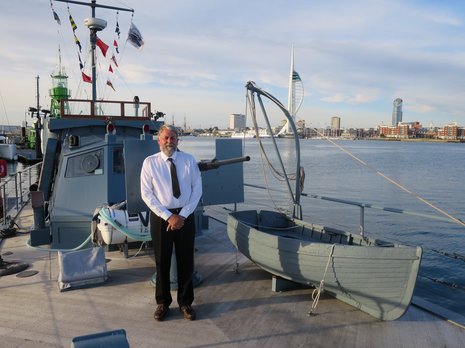 There’s much to report about my three day visit with Raymarine’s impressive product development team, but the impromptu kicker was a visit to HDML (Harbour Defense Motor Launch) #1387, and the vessel’s key story couldn’t be more timely. 70 years ago yesterday, well before D-Day H-Hour, 1387 headed toward Normandy loaded with electronics that helped her crew precisely mark the planned final channel to Omaha Beach, first for the minesweepers and then for the vast fleet of landing craft that left Portsmouth behind her. And today she’s headed for France again, this time with an all-volunteer crew led by Alan Watson, the gentleman who so kindly showed me around last evening.
There’s much to report about my three day visit with Raymarine’s impressive product development team, but the impromptu kicker was a visit to HDML (Harbour Defense Motor Launch) #1387, and the vessel’s key story couldn’t be more timely. 70 years ago yesterday, well before D-Day H-Hour, 1387 headed toward Normandy loaded with electronics that helped her crew precisely mark the planned final channel to Omaha Beach, first for the minesweepers and then for the vast fleet of landing craft that left Portsmouth behind her. And today she’s headed for France again, this time with an all-volunteer crew led by Alan Watson, the gentleman who so kindly showed me around last evening.
There’s a good basic history of Medusa at National Historic Ships UK and much more detail at The Medusa Trust. Though still considered an honorary member of the Navy — thus the honest HMS designation and today’s visit by Princess Anne — the vessel is actually cared for by a small support group. During her last major refit (done largely by student shipwrights), they strove to restore the original HDML configuration but with a willingness to mix in modern equipment to keep her safely operational. So while the rudder angle indicator visible behind the wheel is entirely mechanical, tucked in the corner is a modern DSC VHF supplied by sponsor Raymarine, where Alan Watson also serves as the radar and navigation trainer.
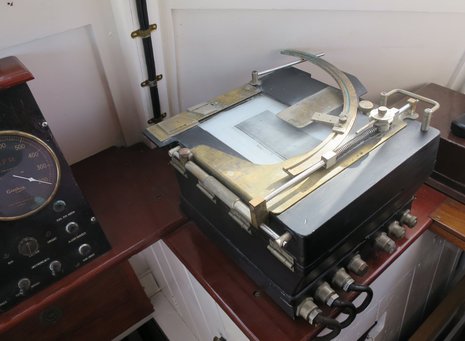 Apparently, it’s mainly Watson who’s scavenged examples of Medusa’s D-Day era electronics, like the ASDIC sonar seen mounted in the wheelhouse above. As explained here, this was actually what we call Forward Looking Sonar, though at a very low frequency with paper and audible output mainly useful for spotting submarines. The various brass appendages comprise a mechanical computer that helped time the release of small depth charges that were literally rolled off the side deck of the HDML. The ASDIC could also be used in passive mode to detect pings, and that was critical for the D-Day mission as a seabed acoustic beacon had already been dropped at the edge of the mine field where Medusa was to stand station for 36 hours.
Apparently, it’s mainly Watson who’s scavenged examples of Medusa’s D-Day era electronics, like the ASDIC sonar seen mounted in the wheelhouse above. As explained here, this was actually what we call Forward Looking Sonar, though at a very low frequency with paper and audible output mainly useful for spotting submarines. The various brass appendages comprise a mechanical computer that helped time the release of small depth charges that were literally rolled off the side deck of the HDML. The ASDIC could also be used in passive mode to detect pings, and that was critical for the D-Day mission as a seabed acoustic beacon had already been dropped at the edge of the mine field where Medusa was to stand station for 36 hours.
Medusa also had two forms of LORAN-like electronic position finding which are explained here. The black device at left is part of the GEE system, and that handle suggests how the receiver module could be switched out with a last minute change of the shore station frequencies. Alan is pointing at the vessel’s radar, which could only look forward with its fixed yagi transmit antenna. Dual fixed receive antennas were used to give some sense beyond range of where a target was in the radar’s 60 degree beam, but like the other gear it seems like an artful operator was mandatory.
The gray box at right is an IFF, as in friend or foe identification, which could send out an ID signal on the radar frequency that a similarly equipped friend could automatically reply to. Watson thinks of the technology as an early form of AIS. Medusa also had a RACON-like directional radio beacon that was activated so that the Allied fleet could home into Medusa and the mine cleared channel.
Yes, I had a wonderful time visiting this historic vessel and couldn’t help but ham it up while feeling what work it is for the engineer to shift the original twin Gardiner diesels in response to bell commands from the bridge or wheelhouse. The pride and good cheer of her volunteer stewards were also infectious. But I’m also aware of the solemn side of this occasion. 70 years ago my dad was leading an artillery company up through southern France and would lose more friends and most of his hearing before it was all done. And he got to go home to a country that hadn’t been ravaged by bombs and nearly conquered.
Apparently, the jaunty 1944 sailor seen at lower right below, now 90 years old, was back aboard Medusa yesterday, and note the Hitler imitator at upper left. I’ll be traveling home today, but when I can, I’ll follow Medusa on Marine Traffic. I imagine she’ll be the talk of the English Channel as she crosses all that traffic.



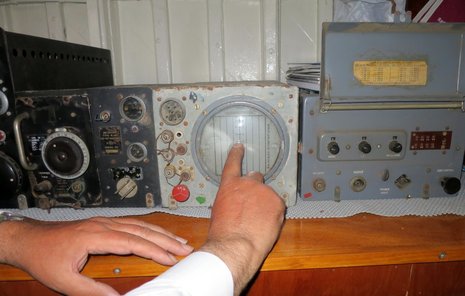
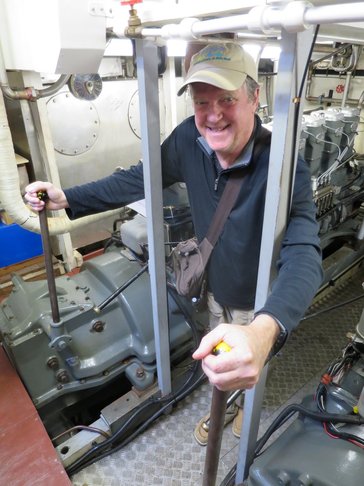
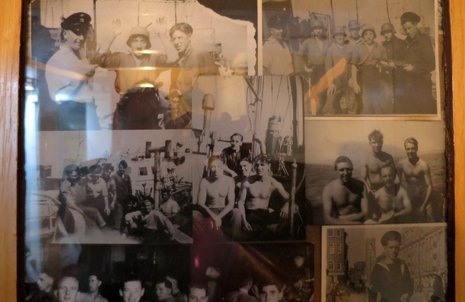

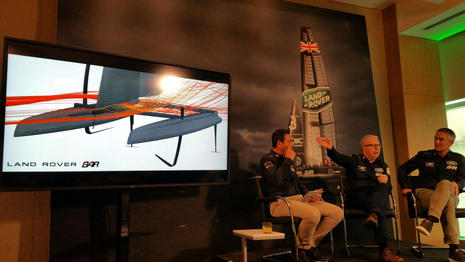










What a great post Ben!
Ben, you should visit the KNM “Hitra” some time. The last sailing subchaser AFAIK, with much original equipment. Sadly, it’s not longer possible to experience the vertical shaft pancake engines.
I think you mean “ravaged” not “ravished”.
BTW, who paid for your trip to the UK?
How cool!
It is amazing the technology then and now. Not too long ago radar for the recreational boater was unheard of, but now is almost expected!
What a great vessel to be on Ben! Especially given the day.
All the best to all and may we always remember the price of freedom is not free.
Great article Ben! I shows how far we have come and how smart they were back then in paving the way for us. Also thank you to your Dad for his sacrifices to keep us safe and free!
Super cool!
Ben,
Thank you for the glimpse of history. I doubt that many of us knew anything about the electronics aboard Medusa. It sounds as if she had some very advanced technology for the time and the critical mission. Thanks to those who served and fought for the freedom of the entire World!
Thanks for the edit, Anonymous. Raymarine covered the travel expenses for me and about 18 other writers from the U.S. and Europe. It’s common practice and does not mean any writer’s opinion is being purchased.
Great to hear the interest in HMS Medusa, but sorry to see that she has not yet headed across the Channel. They did go to Southampton today and then back to Portsmouth/Gosport, but maybe they uncovered a mechanical issue. I’ll ask.
Alan Watson showed me an interesting book called D-Day Operations Manual, “Insights into how science, technology and engineering made the Normandy invasion possible”:
http://www.amazon.com/D-Day-Neptune-Overlord-Battle-Normandy/dp/0857332341#
HMS Medusa is approaching the Normandy coast at cruising speed of 10 knots, which is about 800 rpm on the Gardiners:
http://www.marinetraffic.com/en/ais/details/ships/235082995
Here’s a great article on the analog fire control computers used on US battleships in WW2:
http://arstechnica.com/information-technology/2014/03/gears-of-war-when-mechanical-analog-computers-ruled-the-waves/
Great Post, Ben. I love the history behind these vessels. Too bad the changing of the guard is taking place and all those heroes of WWII are leaving us. What an amazing generation.
A fun post, Ben. My father was in the British Merchant Navy, 1941-52, and I had a somewhat similar visit last year to HMCS Haida, a ship that almost certainly increased his odds of living, and hence my own. I wrote about it here: http://alchemy2009.blogspot.ca/2013/08/my-creator-and-his-destroyer.html
Yipes, the Murmansk Run. Thanks, Marc.
It’s nice to see you recognize the term “Murmansk Run”, Ben. Plenty of American ships did it in convoy with the Brits, usually after changing cargoes in Liverpool.
It’s also interesting to note that no amount of cutting-edge tech helped those merchant sailors as much as did 24-hours-a-day axe work to break off the frozen spray off the superstructure. More than one laden ship passed its angle of vanishing stability due to ice weight aloft, rolled in seconds and went straight to the bottom. My father remarked that the noise of smashing ice was unrelenting, as it was considered a worse threat than the U-boats. The destroyer escorts, which usually had less freeboard and wetter decks, had it worse, but they also had bigger crews.
So, having a steel sailboat, we’re bringing an axe! We may not sail north or south of 57 degrees, but it’s good insurance.
Fascinating post Ben! Thanks so much for the glimpse into the D Day use and electronics of the day.
I always was interested in early electronics and have gathered a small museum in my shop, though the oldest is circa 1949, a tetrode power amplifier tube that was hand blown and is a perfect example of why screen grids got their name. The grid looks just like a door screen section.
Rick Beck
It was the weather that delayed Medusas departure. We left at 0300 into a nasty beam swell and rolled through 80 degress a few times plus intense thunderstorms. We visited Oiustreham and caen where the ship was presented with medal by the mayor, then into the Mulberry harbour at arromanche then to Omaha and Point Du Hoc where the Rangers scaled the cliffs. A short visit to port en Bessin which was memorable for a lone veteran standing to attention and saluting on our departure. A days R&R in Cherbourg and then head for home. We stopped on teh spot where Medusa marked the minefield on D Day and held a short service followed by a red rose for each crew member onto the water. We then found the wreck of an LCT (landing craft tank) from Omaha in 50m of water using the Raymarine CP100. Back in Portsmouth we had steamed 400 miles on 75 year old engines without a hitch…mission accomplished.
Thanks for the report, Alan, and congratulations. I did follow your voyage via AIS but can only imagine how much the people of Normandy appreciated the sight of HMS Medusa. I dare say you were the talk of Channel shipping as well?
Meanwhile, I purchased a copy of the Haynes “D-Day Operation Manual” you showed me and am quite entranced. I’m amazed by just the intro shot of the Canadian infantry carrying bicycles as they disembark into the water off Juno Beach from an LCI(L). It’s hard to picture how they carried all their gear, particularly long guns, while biking but no doubt the planners had come up with something.
Do I recall that Medusa plans to visit Amsterdam next year, to honor the fact that it was the first Allied naval vessel to reach that fair city?
We certainly had some interest from shipping, fishing boats seemed to head the other way probably because they thought we were fishery protection.. We are at the early stages of planning a visit to amsterdam to conincide with teh 70th of VE day in May next year. Medusa took the surrender at Ijmuiden and was then the first Allied vessel to reach amsterdam. She went gingerly up teh North Sea canal past block ships and booby traps with two crew in the dinghy rowing ahead adn poking anything suspicious with a boathook.